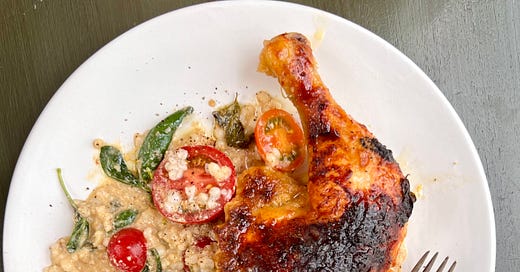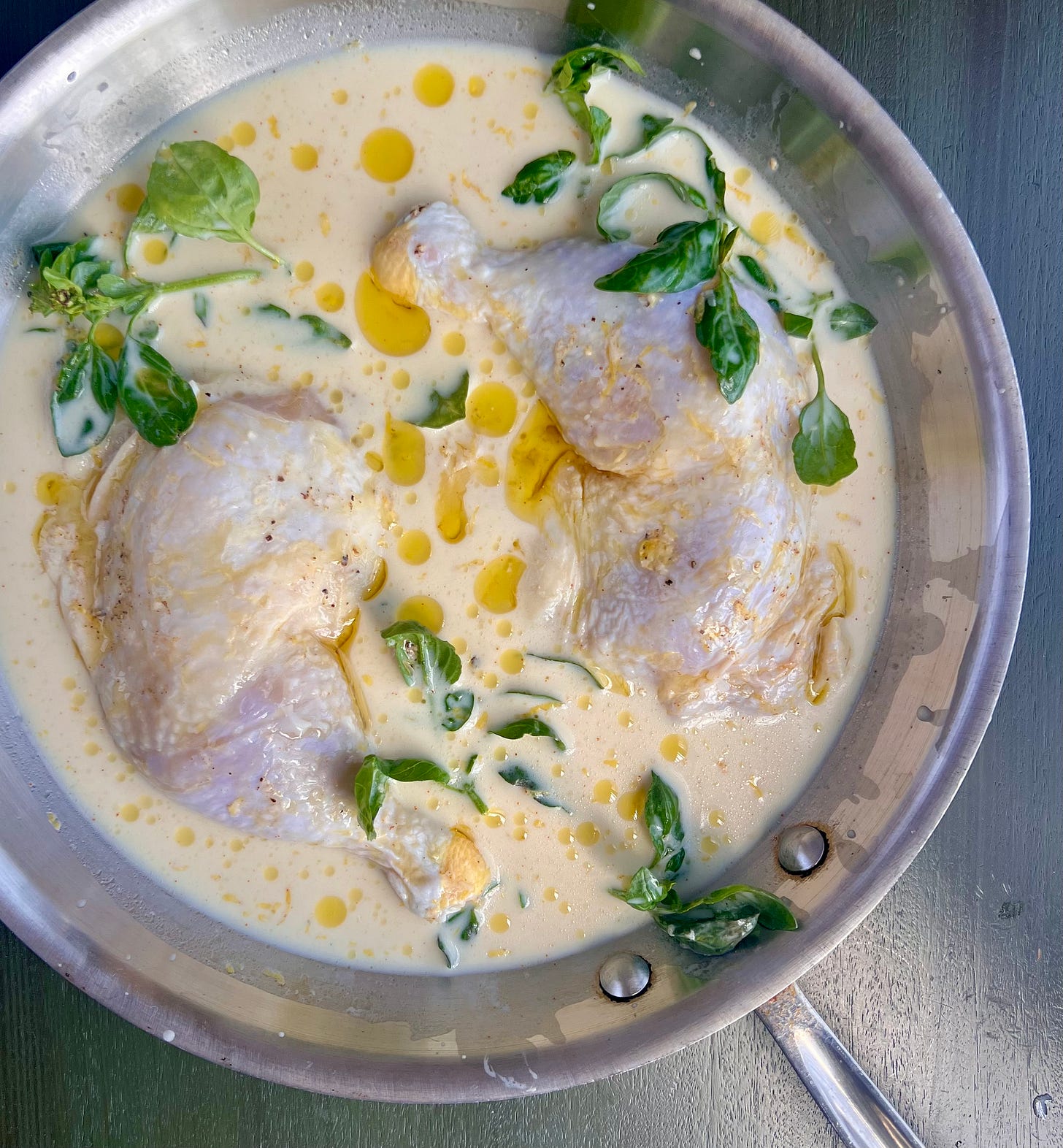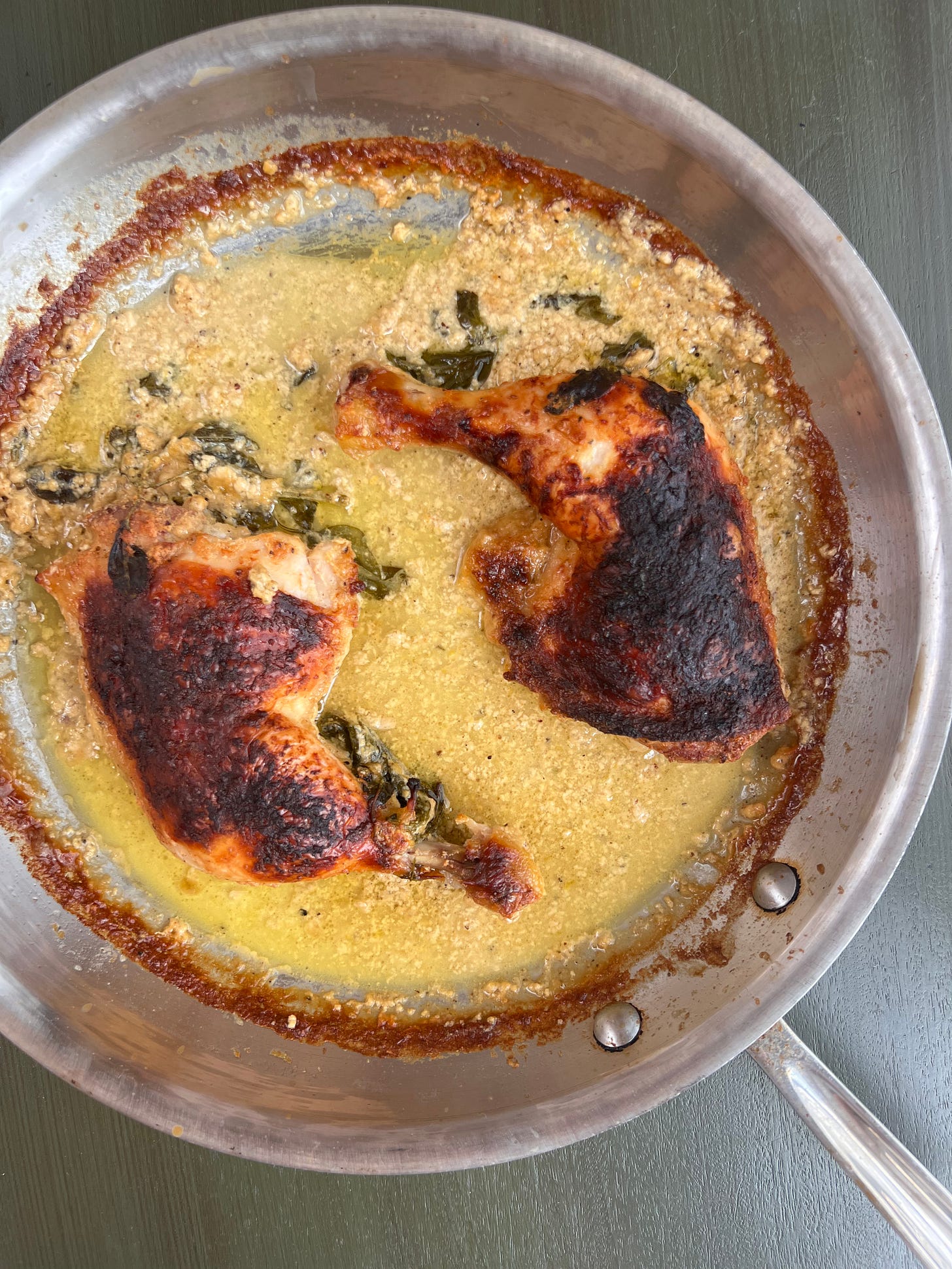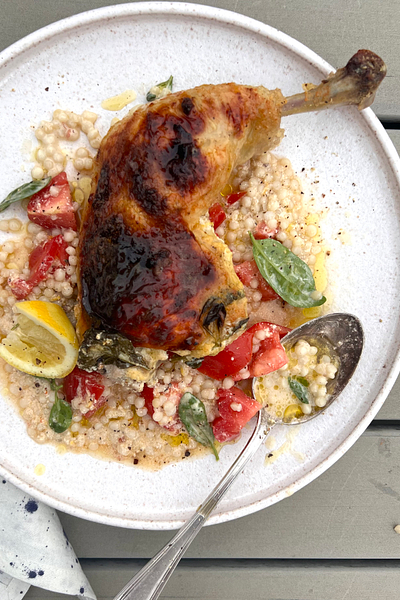The Margarita Effect: Romance Novel Edition
And a Recipe for Salt + Vinegar Buttermilk Chicken with Tomatoes and a Carb
My fork tines tap against her thighs. Crack. Crackle.
I take rips of the brazenly crisped-up skin from both drumsticks because I’m solo in that moment and don’t have to share with the person I’d like to be sharing with, who’s 3,000 miles away.
The broth is great— as if Cape Cod Salt + Vinegar chips were to meet an actually delicious cream of chicken soup. I use the chicken’s shattering exterior like a mussel shell, lapping up the liquid while simultaneously crunching on the fatty vessel. Really feeling myself. Nailed the development of this recipe on the first try. “One and done,” I’m thinking.
And then, tugging to release the drumstick from the thigh– a bit barbarian but who’s looking– I’m met with an entirely unforgiving, unyielding joint. Baffled.
I cook legs for their tenderness, for that pull-apart moment, for the feeling of flesh freeing from bone. And yet, this preemptive pat-on-the-back iteration is tough, tough, and still tougher, like a rubberless, bandless rubber band. Weirdly fibrous… straight-up nasty.
I made this chicken a month ago, didn’t measure or pay much mind to what I was doing, and decided to pull the meat from the bones to serve in tacos. Friends came over, proclamations of “best chicken ever” were made, and rugs were cut. (Talk about margaritas.)
So then why, in poor poultry’s name, is it that when I tie on the apron to develop the recipe formally— measuring and weighing and timing and all the etc.’s— am I left with something I’d never dance the night away to, nor nudge into NOODLE’s archives?!
The answer comes in the form of a phrase that I normally relegate to margarita consumption: TOO MUCH OF A GOOD THING.
In this scenario, we’re talkin’ too much vinegar in the ol’ marinade. When aiming to recreate the first go-‘round, I cruised with unpumped brakes, pouring more and more and more vinegar into the marinade, until I reached a ratio of 2 cups milk to 7 tablespoons of vinegar. (For reference, the typical quantity to acidify 1 cup of milk would be 1 scant tablespoon.) All in an effort to drive home the whole “Vin for the Win” concept.
Acid– be it in the form of buttermilk, yogurt, or straight-up vinegar (yesss escabeche) tenderizes the fibers of proteins (especially tough ones). But there’s a balance. If you disrupt it, that little pill goes down all jaggedy– 90’s style– and is even harder to swallow when you chose to pay $18 for 2 legs at the farmer’s market rather than $6 for 2 legs at Whole Foods.
In short, too much vinegar will take protein from tender to tough in the blink of a thigh.
Today, I can’t help but think, as I sit writing in a doctor’s waiting room watching Deal Or No Deal, about the risks we take in the kitchen. Stakes aren’t quite the same as those on the show, since a million bucks isn’t generally on the line when we cook (and definitely absent are the 26 briefcase-slingin’ ladies in getups) but it costs money to feed ourselves, and massively botching something can sting.
So…with this recipe, more than ever, I’m proud of my newsletter tagline proclaiming that “I Noodle So You Don’t Have To.” I’ve worked out the kinks with these legs, and they’re better for it.
Here’s the outline: Make some DIY buttermilk with milk and distilled white vinegar. Add lemon zest, grated garlic, nutritional yeast (for more than just popcorn or… vegan food), cayenne, olive oil, and lots of salt. Bathe your chicken for 24 hours (60 minutes is also just fine), throw into a skillet with the buttermilk marinade and some basil sprigs, and roast at a high temp. The braising liquid kind of curdles but it’s yummy and bright and slightly… cheesy? Finish with more distilled vinegar and lemon. Cue the pucker! Plus basil and tomatoes… and carb of your choice.
Shred the meat for tacos, eat like the photos show with Israeli couscous or a grain, or fold into hefty greens for a wilted kinda salad, using the sauce as a vinaigrette of sorts. Serve and sop up juices with the ubiquitous “crusty bread” that, despite how overplayed the suggestion is in recipes these days, is overplayed for a reason.
Expect the sauce to have a texture of curds + whey. And when eaten cold, the bits of chilled buttermilk have a nearly feta-like effect, speckled throughout the sauce. Almost worth making for the leftovers alone.
If you prefer a smoother sauce, puree the cooking jus after roasting. It’s super velvety and an entirely different experience… but not necessary! Both versions of the sauce have their merits.
I cringe a bit here, but I’m terrible at keeping things to myself: immediately after the final execution of this recipe, once I’d locked the right ratios of the marinade and consumed every last morsel, I found my tongue acting of its own volition without even checking with the part of my brain that controls physical function: I came eye-to-eye with my vacant plate. Stared it right in the face, at eye-level. And licked it.
SALT + VINEGAR BUTTERMILK CHICKEN WITH TOMATOES AND A CARB
Serves 2 (Doubles easily!)
REMEMBER, BEST PRACTICE: READ THE RECIPE ALL THE WAY THROUGH BEFORE YOU START COOKING!
This recipe doesn’t call for buttermilk because… you’re making your own by combining vinegar and milk. Avoid using cast iron for cooking: the acidity of the vinegar will react in untasty ways. And If you want a kick, say yes to the cayenne. Up to you.
Expect the sauce to have a texture of curds + whey. Bonus: when eaten cold, the bits of chilled buttermilk have a nearly feta-like effect, speckled throughout the sauce. Almost worth making for the leftovers alone.
Another great way to serve this? Return the chicken legs to the skillet when you finish the pan sauce. Tear up the chicken directly in the skillet, saucing as you go, and serve, in a more shreddy kind of manner.
If you choose to double the recipe, no need to double the amount of marinade. Increase only by one-half.
2 large chicken legs, about 2 pounds
1-2 juicy lemons
2 ¼ cups whole milk
2 tablespoons distilled white vinegar, plus additional for serving
2 tablespoons olive oil, plus additional for the sauce and serving
1 tablespoon nutritional yeast
2 cloves garlic, finely grated
Kosher salt and freshly ground black pepper
¼ teaspoon cayenne pepper (optional)
1 bunch basil
10 ounces (about ¾ of a pint) cherry tomatoes, halved
½ cup Israeli couscous (You can also serve with any cooked, toothsome grain, such as wheat berries, farro, barley, or brown rice)
Maldon salt, for serving
1. Place the chicken legs in a large resealable plastic bag. (You can also marinate in a bowl but I like the “surround sound” quality of a Ziplock.)
2. Finely grate the rind of one lemon and add the zest to a medium bowl or large measuring cup. Reserve the zested lemon for serving. Add the milk, vinegar, 1 tablespoon olive oil, nutritional yeast, garlic, 1 tablespoon plus 1 teaspoon salt, 1 teaspoon black pepper (really measure it– don’t skimp), and cayenne pepper, if using. Whisk to combine.
3. Scrape the marinade into the bag with the chicken (placing the bag into a bowl can help keep the bag upright). Push out all of the air and seal. Transfer to the refrigerator (in the bowl, to safeguard any potential leaking), and let marinate, at least 1 hour and up to 24, flipping the bag a couple of times if you think about it. Try to marinate for at least 4 hours if you have the time. You’ll be able to tell the difference!
4. When ready to cook, preheat the oven to 425 degrees. Transfer the chicken and all of the marinade (get every last drop!) to a shallow stainless steel or enamel cast iron skillet just big enough to give the chicken some breathing room. If you’re finding that the sauce reduces so much that it is starting to burn during cooking, worry not! Add splashes of water to the skillet as necessary if the sauce level gets low.
5. Drizzle the tops of the legs with the remaining 1 tablespoon of olive oil. Nestle about 4 basil sprigs into the pan and transfer to the oven.
6. Roast for 30 minutes. Generously baste the top of the legs with the cooking liquid (don’t worry… it’s supposed to look like curds and whey). Return to the oven (rotating the pan to encourage even browning) and continue roasting for an additional 20-25 minutes, until the skin is deeply golden.
7. Increase the temperature to 450 and continue cooking until the skin is even more deeply burnished, the chicken is super tender, and the cooking liquid has reduced by about half, about 10-15 minutes more. (Test this by wiggling or pulling at the drumstick. It should move freely. You may even be able to pull the bone out entirely. Or, use a fork to pull lightly at the edges of the chicken. The meat should shred easily.) Legs are hard to overcook so be bold about really taking the skin to the dark side.
8. While the chicken roasts, cook Israeli couscous (or any grain of your choice, cooked to its specification): bring a medium pot of water to a boil. Salt generously. Add the Israeli couscous and cook until just tender, 6 to 8 minutes. Drain.
9. When the chicken has finished cooking, transfer the legs to a plate. Now for the pan sauce: if you have a good amount of cooking liquid in the skillet (about 1 cup or so), great. If you have much more than that, place skillet over high heat and cook, stirring, until reduced to about a cup.
Or, if your sauce is thick and reduced and shy of 1 cup of sauce, place over medium heat and begin adding water, a tablespoon at a time, while scraping the sides of the pan to incorporate any brown bits into the sauce. The goal is to make enough sauce to serve with your chicken and dress your choice of accompaniment. Let simmer for a minute, whisking to combine.
10. Here’s where the vinegar comes back in. With the heat on medium, add 1 teaspoon of vinegar. Whisk to combine, and taste. The sauce should be bright, punchy, and reminiscent of salt + vinegar potato chips. Add more vinegar, a teaspoon at a time, until your desired level of vinegary pucker is reached. (During testing in different ovens, there were some iterations that wanted 1 teaspoon of vinegar, and others that tasted best with 3 teaspoons. Every oven is different and will reduce the sauce at different rates. Use your tastebuds to help guide you!)
11. If desired, transfer sauce to a blender and puree until smooth. This is really just personal preference. Drizzling in some olive oil during blending will add a nice richness, too. Return blended sauce to the skillet.
12. Add tomatoes to the pan, stir to incorporate, and cook 30 seconds, just to warm through. Squeeze the lemon into the skillet, along with a handful of basil leaves. Season to taste with salt and pepper and serve in shallow bowls with the chicken legs and Israeli couscous. (You can also shred up the chicken and the crispy skin directly in the skillet, saucing as you go, rather than serve the legs whole). Garnish with additional lemon, a drizzle of olive oil, and Maldon salt, if desired.












